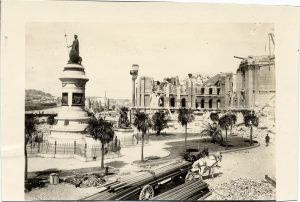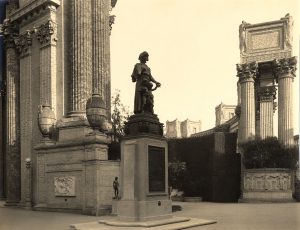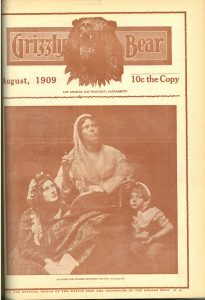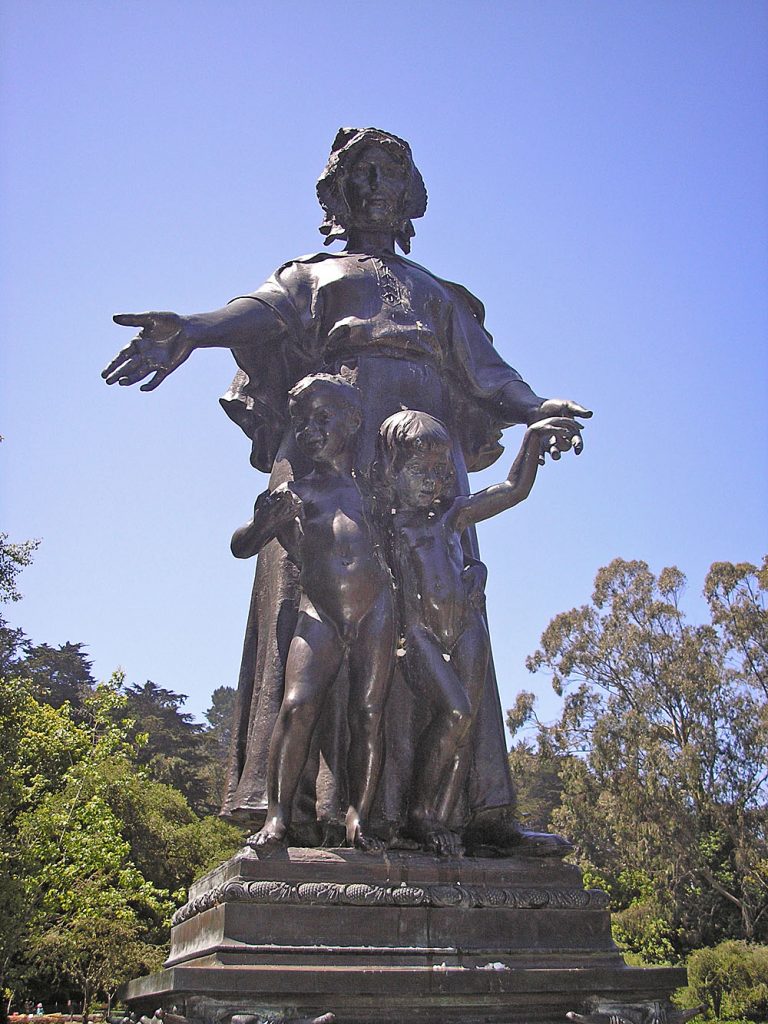Competing visions of pioneer womanhood collided in the creation of this statue. The tribute to early Euro-American California settlers was created for San Francisco’s 1915 Panama-Pacific International Exposition. It was forgotten after the fair, but later restored and moved to its permanent location in Golden Gate Park in 1940.

Mighels’ efforts inspired the creation of the Pioneer Mother Monument Association (PMMA). Led by President Helen Sanborn, the association organized a fundraising campaign. They planned to erect a monument “symbolizing Motherhood, to be dedicated to the Pioneer Mothers of the West – the self-sacrificing women who, with their little ones at their side, braved the dangers and underwent the hardships and privations that are always incident to pioneer life.”[1] They envisioned a woman and two or three children in mid-19th-century clothing, with a gold miner father in the background or in a bronze relief panel on the statue’s base.
Mighels and the PMMA struggled to raise support for the statue until the Panama-Pacific International Exposition (PPIE) Woman’s Board got involved. The PPIE Woman’s Board sought to place the monument at San Francisco’s 1915 world’s fair. The PPIE was intended to celebrate San Francisco’s recovery from the 1906 earthquake. The Pioneer Mother monument would join the earlier monuments to California men that had survived that earthquake.


Francisco.
The PMMA and various California pioneer associations pledged to fundraise for the project. But tension soon developed between John Trask, chief of the PPIE’s fine arts department, and the club women sponsoring the statue. Some of the women questioned Trask’s choice to commission a prominent eastern sculptor. They believed it should be done by a local artist. But Trask was a leading figure in the fine arts establishment. He was convinced that no California artist was qualified for a project of this significance. He gave the commission to his friend Charles Grafly instead.
Grafly abandoned both Mighels’ image of a hoop-skirted woman holding church at her knee and the PPMA’s vision of a pioneer woman in a more practical prairie-style dress. Instead, Grafly sculpted a woman clad in the fringed buckskin and moccasins that many easterners associated with the Wild West. The sculptor surrounded his pioneer women with nude children symbolizing the future.
Grafly’s model produced outrage in San Francisco because it blurred racial and gender identities. A decade earlier, Portland, Oregon, had welcomed a sculpture of Sacajawea as a tribute to white pioneer mothers. But in 1915, San Franciscans balked at Grafly’s depiction of a white woman dressed in Native clothing. Pressure from the Native Daughters of the Golden West and other women’s pioneer associations persuaded Grafly to replace the “costume of a primitive Sioux Indian squaw”[2] with a homespun gown and simple leather shoes. Under pressure from the female donors, Grafly also agreed to adjust the head covering. But even the final version lacked the wide brim characteristic of mid-nineteenth-century sunbonnets designed to protect white women’s fair complexions from the sun.
Some of the clubwomen sponsoring the monument – including Mighels – also were outraged that Grafly insisted on depicting nude children. PMMA president Sanborn insisted that the children’s nudity made it impossible for the organization to raise public subscriptions to support the monument. But Grafly remained determined to maintain the allegorical quality of the children at her feet. Philanthropist and honorary president of the PPIE Woman’s Board Phoebe Hearst and U.S. Senator (and former San Francisco mayor) James Phelan finally brokered a compromise. They persuaded Grafly to make the boy’s genitalia “somewhat less conspic[u]ous,”[3] and thus less offensive to Anglo women’s genteel sensibilities.

Public opinion of the revised statue was generally positive. More than one thousand people visited the artist’s studio to view the completed statue, which they agreed was a “symbolical masterpiece.”[4] Thousands of California schoolchildren contributed pennies and nickels toward erecting the monument, including $651.59 in San Francisco and $591.94 in Los Angeles (a total of about $30,000 in 2015 dollars).
The Pioneer Mother monument was cast in bronze to make it a permanent fixture in San Francisco, but it received less attention at the PPIE than did the plaster Pioneer and End of the Trail. After the fair, those pieces were moved to Visalia’s Mooney Grove Park. But Grafly’s bronze Pioneer Mother was neglected and forgotten. A quarter-century later it was discovered, weather-worn and vandalized, in the near-ruin of the Palace of Fine Arts. Within three months of its discovery, civic and historic groups helped to restore the monument, and it was displayed at the Golden Gate International Exposition before being installed at its final site in a meadow in Golden Gate Park on December 8, 1940.
Related Monuments:
Frank Happersberger, Lick Pioneer Monument, 1894
Douglas Tilden, Admission Day Monument, 1897
Solon Borglum, American Pioneer, 1915-1980
James Earle Fraser, End of the Trail, 1915
Explore:
San Francisco Pioneer Monuments Walking Tour powered by Clio
Northern California Pioneer Monuments Driving Tour powered by Clio
Notes:
[1] “Motherhood Monument.” The Journal of Education 80, no. 9 (September 17, 1914): 240.
[2] “Pioneer Mother Draped Like a Sioux Squaw.” San Francisco Chronicle undated clipping. Charles Grafly Papers, Wichita State University Libraries Special Collections.
[3] Telegram from Phoebe A. Hearst to Charles Grafly, December 31, 1914, Charles Grafly Papers box 7, folder 20, Wichita State University Libraries Special Collections.
[4] “Viewed Sculptor’s Masterpiece: Thousands Impressed With ‘Pioneer Mother’ at the Grafly Studio,” Gloucester Daily Times, October 19, 1914, Charles Grafly Papers.